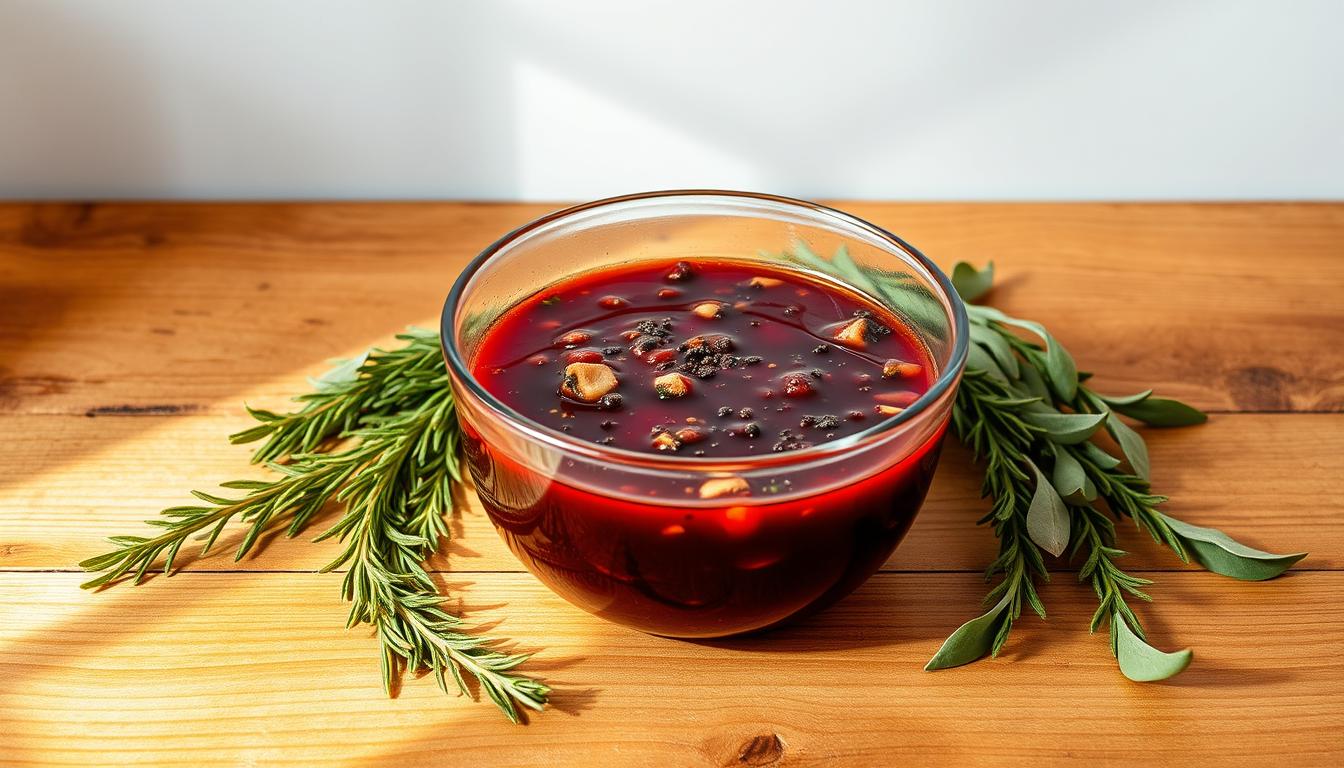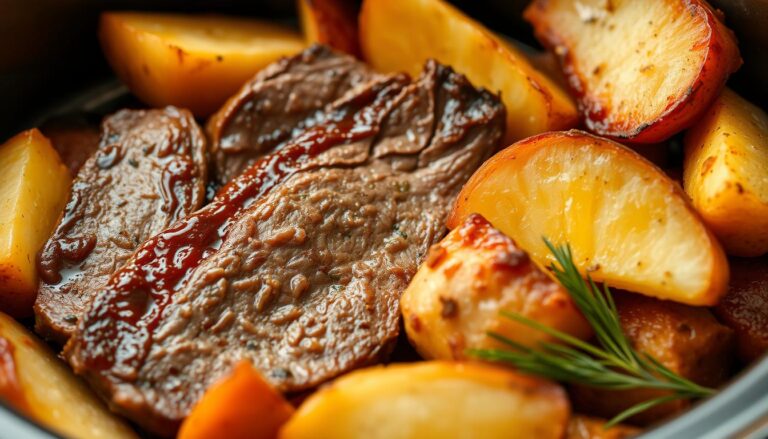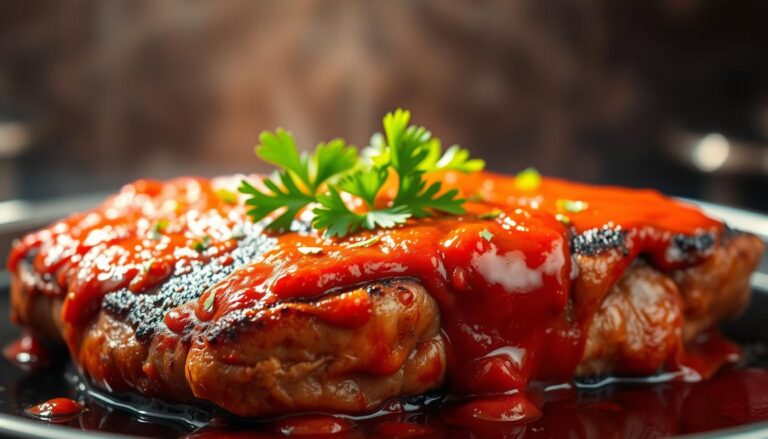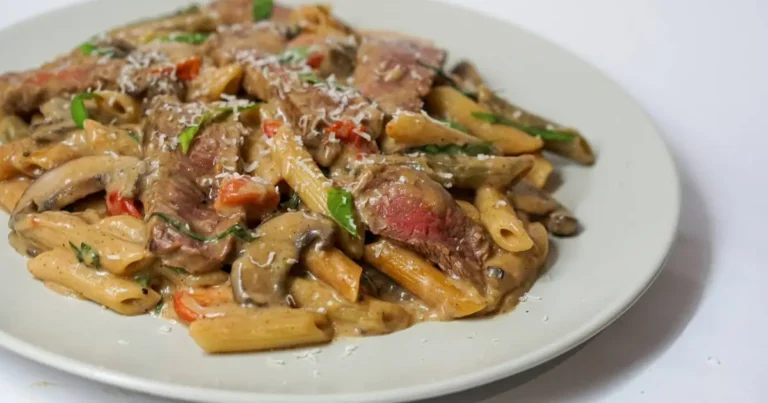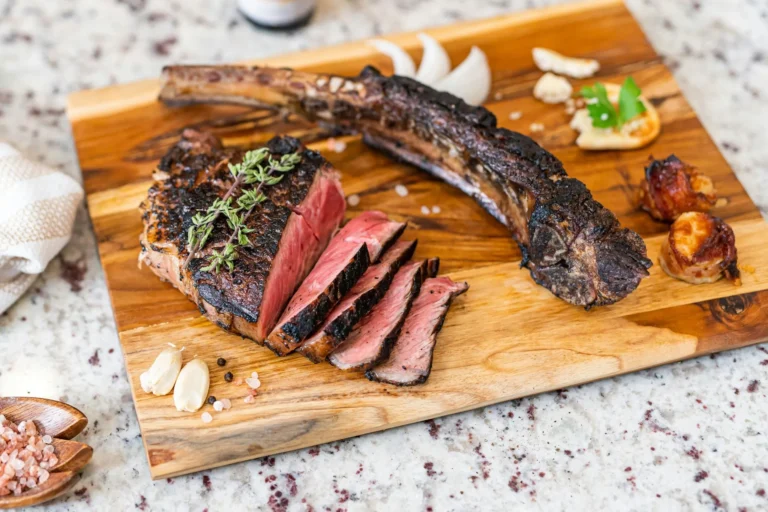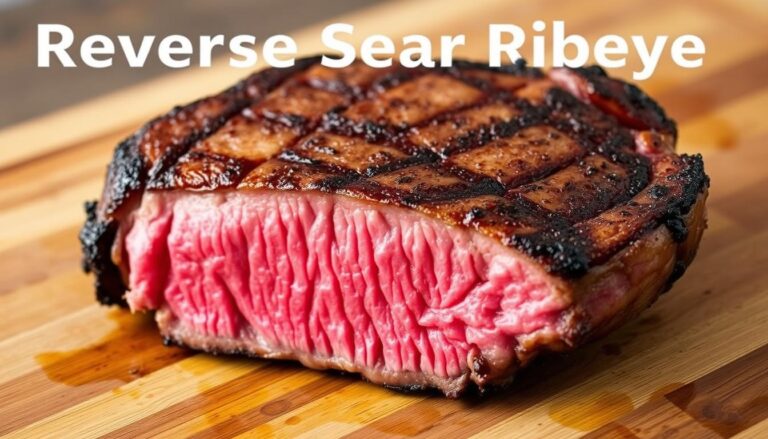Flavorful Venison Marinade: Tips & Recipes
You remember the first time you cooked wild game for friends — the nerves, the hope that the meat would be tender and true to its flavor. You want every bite to honor the animal and the season. This guide meets that need with clear, repeatable steps that fit weeknights and hunting trips.
You’ll build a reliable toolkit that boosts tenderness and juiciness without hiding the natural notes of backstrap or tenderloin. Learn when to keep things simple and when to reach for bolder mixes for tougher cuts.
Inside, you get three proven recipes, pro timing tips, and practical grill and skillet-to-oven methods. You’ll also see how salt, acid, fat, and aromatics work together so your seasoning and mouthfeel improve every time.
By the end, you’ll have a steady way to shake, marinate, and cook with confidence — plus safe storage ideas and serving suggestions that make marinated meat feel at home on any table.
Table of Contents
Why your venison marinade matters right now
When you cook fresh wild meat this season, your approach should protect the natural notes while adding just enough lift. A proper soak brightens surface seasoning without hiding the character of backstrap or tenderloin.
Understanding lean, wild game flavor in the present season
Soaks and seasoning reach only a few millimeters into muscle. That means most of the flavor and tenderness you notice comes from how you cook the cut.
Aim for medium-rare (about 130–135°F) and let the meat rest 10–15 minutes. Then slice against the grain for the best bite.
How marinades support tenderness, not just taste
- You’re working with lean meat now, so salt and acid season deeply and brighten wild game without overwhelming it.
- Expect surface improvement: true tenderness depends on precise cook time and temperature control.
- Balance acid and aromatics to reduce strong gamey taste and preserve natural flavor.
- A short soak gives you more room for error on a busy weeknight.
| Cut | Soak Time | Primary Benefit | Cook Goal |
|---|---|---|---|
| Backstrap / Steaks | 1–4 hours | Surface seasoning, brightened flavor | 130–135°F, rest 10–15 min |
| Tenderloin | 30–90 minutes | Subtle lift, preserve natural taste | 130–135°F, thin slices |
| Roasts / Tougher cuts | 6–24 hours | Deeper seasoning, perceived juiciness | Low finish temp or long roast, rest well |
What makes a great marinade for venison
The best results come when you use each ingredient to do a specific job—season, tenderize, carry flavor, or brighten. Keep your mix focused so the natural character of the meat stays forward.
Salt and soy sauce: penetration and seasoning
Salt and soy sauce jump-start seasoning by drawing flavors inward. They also help surface proteins brown for a better crust on lean cuts.
Acid and juice: brightness and balance
Use a touch of red wine vinegar or lemon for lift. A splash of apple juice adds mild sweetness that caramelizes nicely when you sear.
Fat and oil: carry flavor
Olive oil or another neutral oil carries fat-soluble aromas and gives a light protective coating to very lean venison.
Aromatics and spices: layer without masking
Finish with garlic cloves, coriander, rosemary, Italian seasoning, and cracked black pepper. These add depth but let the cut speak.
- Match salt/acid balance to your target: more acid for roasts, less for premium cuts.
- Mix in a jar or bowl, shake well, and pour for even coating.
All-purpose venison marinade (olive oil, red wine vinegar, lemon, garlic)
A simple shake-and-rest mix gives you a reliable base for steaks, kebabs, and roasts.
Ingredients: 1/4 cup olive oil, 2 Tbsp red wine vinegar, juice of 1/2 lemon, 3 garlic cloves minced, 1 tsp Italian seasoning, 3/4 tsp salt, 1/2 tsp pepper.
Combine the ingredients in a bowl or a lidded jar. Whisk or shake vigorously until blended. This all-purpose venison marinade covers 1–2 pounds of meat evenly.
- Place meat in a shallow dish or resealable bag.
- Pour the mix over the meat, turn to coat, and seal.
- Refrigerator time: at least 1 hour; 4 hours to overnight (8–9 hours) helps tougher cuts.
- Remove excess liquid, then cook venison hot and fast to sear—kebabs take about 3–4 minutes per side.
| Use | Amount Covered | Recommended Time |
|---|---|---|
| Backstrap / Steaks | 1–2 lb | 1–4 hours |
| Tenderloin | 1 lb | 30–90 minutes |
| Roasts / Tough Cuts | 2+ lb | 4–8+ hours (overnight) |
“Super Juice” wild game marinade with Worcestershire and soy
This bold “Super Juice” sauce turns pantry staples into a savory boost for your next cook.
Recipe: 1/2 cup Worcestershire sauce, 1/2 cup soy sauce, 1 Tbsp smoked paprika, 1 Tbsp cracked pepper, 1 Tbsp minced garlic (about 2–3 cloves), 1 Tbsp rosemary, 1 tsp sea salt.
Mix the ingredients and add your meat. This mix works great on steaks, backstrap, or tenderloin and is a noted family favorite of Jeremiah Doughty.
Pantry-friendly ingredients and simple ratios
You can make a bold, pantry-friendly soak with equal parts Worcestershire and soy. Smoked paprika and rosemary add warmth while pepper and salt deepen savory notes.
Directions and timing
Marinate your venison between 4 and 24 hours, depending on thickness and desired intensity.
Drain well before cooking to prevent flare-ups. Then cook on high heat—either a hot grill or a ripping-hot pan—to get a fast, flavorful crust.
| Use | Ratio | Marinate Time |
|---|---|---|
| Steaks / Backstrap | Equal Worcestershire : soy | 4–8 hours |
| Tenderloin | Same mix, lighter soak | 4–12 hours |
| Larger or thicker cuts | Increase aromatics slightly | 12–24 hours |
Apple-ginger venison marinade for balanced sweet-savory flavor
This apple-ginger mix gives a sweet, savory lift that keeps the meat’s natural tone. Use it when you want bright fruit notes with warm ginger and garlic backing.
Ingredients (makes enough for 2–3 pounds): 2 cups apple juice, 1/2 cup real soy sauce, 3 Tbsp olive oil, 1/2 tsp ground coriander, 1 tsp ground black pepper, 1/2 medium onion thinly sliced, 1 tsp minced ginger, 5 garlic cloves chopped, and 3 Tbsp chopped cilantro (optional).
Timing and handling
Marinate small cuts for 3–4 hours and larger roasts for 12–24 hours. Adjust timing based on thickness and how salty your soy sauce is.
Arrange meat in a single layer in a food-safe container so every surface is submerged. If needed, weigh the pieces down with a plate to keep them covered.
- You can swap half the apple juice with red wine or sangria for more depth.
- Keep any unused mix that never touched raw meat refrigerated up to one week.
- Watch sugars on high heat; manage hot and cool zones to avoid burning when you sear.
venison marinade times by cut: backstrap, tenderloin, steaks, and roasts
Small cuts absorb flavors fast; large cuts need patience to balance depth without over-salting.
Backstrap and steaks: flavor vs. preserving the natural taste
Backstrap and most steak cuts respond well to moderate soaks. Aim for about 2–6 hours to boost surface seasoning without burying the meat’s natural notes.
For sliced steak or thin pieces, keep closer to the lower end so you get flavor but not excess salt.
Tenderloin: minimal time and careful seasoning
Venison tenderloin is already tender. Limit soak time to 1–3 hours and use lower acid or salt levels so the flesh stays delicate and bright.
Roasts and tougher cuts: longer hours for deeper seasoning
Larger roasts and tougher cuts benefit from extended soaks. Plan 8–24 hours to let the surface seasoning build and to give you perceived juiciness after a long finish.
- Cube stew meat for kebabs and marinate 4–8 hours to increase flavor on small surfaces.
- Adjust hours based on salt: shorter with saltier mixes, longer with milder blends.
- Remember that actual penetration is shallow; final tenderness still depends on proper cook time and resting.
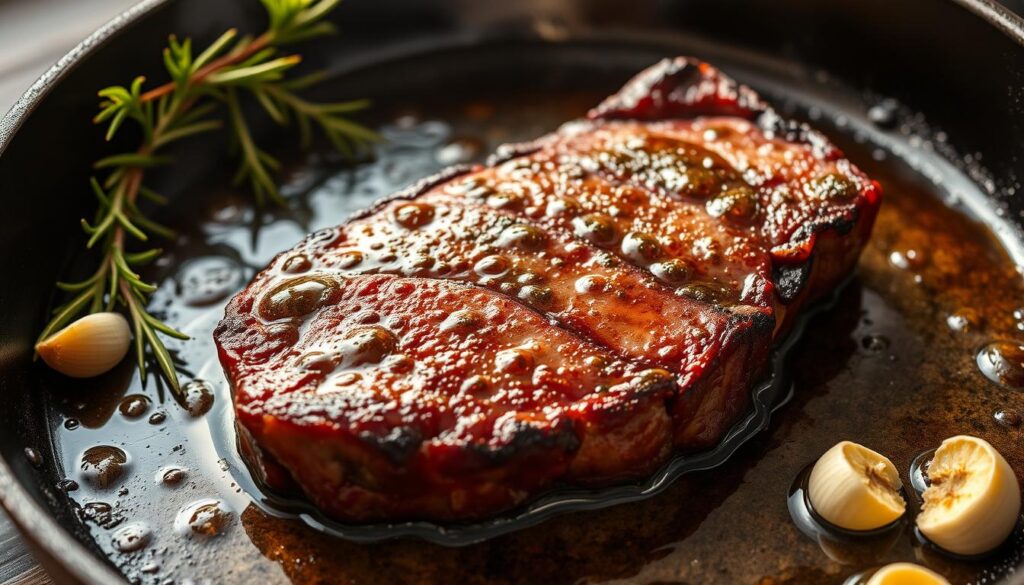
Grill, pan-sear, or roast: cooking venison after marinating
After your soak, the final cook is where texture and flavor truly come together. Your choices now decide crust, juiciness, and how much of the natural game notes show through.
Grill on medium-high: minutes per side and sugar management
Pat the meat dry before you place it on a preheated grill. High sugars from fruit-based mixes caramelize fast and can burn.
Aim for a few minutes per side depending on thickness. If the exterior browns too quickly, move pieces to a cooler zone to finish without charring.
Skillet then oven: sear, then gentle finish
Sear over medium-high heat in a heavy skillet to build a crust. Then transfer the pan to a 225°F oven to finish slowly.
This two-step method prevents scorching while reaching the target internal temperature evenly.
Let rest and slice for best texture
Pull a grilled steak at about 127°F so carryover brings it to roughly 130°F. Let rest 10–15 minutes before slicing.
Always slice against the grain for the most tender bite. Remember, a soak or marinade helps flavor but does not replace proper temperature control.
- Pat dry, preheat to medium-high to sear without burning sugars.
- Use a few minutes per side; shift to a cooler zone if caramelization runs fast.
- Sear, then finish at 225°F in the oven for gentle carryover.
- Pull at ~127°F, rest 10–15 minutes, and slice against the grain.
- Reserve a small portion of unused marinade (kept separate) as a finishing glaze.
Flavor variations and add-ins you can try
A few smart swaps let you shift from bright to smoky without reworking the whole recipe.
Try a red wine or sangria swap by replacing half the apple juice with red wine or sangria. This adds color, tannin, and depth that pair well with hearty cuts.

Build bolder aromatics
Add smoked paprika and rosemary from the “Super Juice” mix when you want warmth and an outdoor, wood-smoked note. Coriander helps cut through strong game and makes the overall flavor more palatable.
“Small changes—an extra teaspoon of pepper or a handful of fresh herbs—often make the biggest difference at the grill.”
- Replace part of the fruit juice with red wine or sangria for a richer profile.
- Use smoked paprika and rosemary with coriander for bolder aromatics.
- Boost black pepper for a steakhouse edge or fold in cilantro to brighten the mix.
- Balance sweetness, acid, and salt so the meat’s natural flavor stays front and center.
- Keep a master base and split batches to test add-ins side by side.
| Add-in | Effect | Use With |
|---|---|---|
| Red wine / Sangria | Depth, tannin, richer color | Apple-ginger, all-purpose blends |
| Smoked paprika + Rosemary | Warmth, smoke, herbaceous lift | “Super Juice”, steaks, backstrap |
| Coriander | Bright citrusy note, balances game | Bold mixes, roasts, tougher cuts |
| Cilantro | Fresh brightness | Apple-ginger, lighter soaks |
Serving ideas: kebabs, salads, and classic sides
Simple serving choices turn a quick cook into a memorable meal for friends and family.
For kebabs: thread bite-sized cubes with peppers, onions, and zucchini for quick, even cooking. Grill the skewers over medium-high heat about 3–4 minutes per side, then let them rest for a few minutes before plating to keep juices in the meat.
Finish and pair like a pro
- You can turn marinated cubes into kebabs with peppers, onions, and zucchini for quick, even cooking.
- You’ll grill kebabs about 3–4 minutes per side and let them rest before serving to keep juices in the meat.
- Slice a grilled steak thin and toss over greens with a vinaigrette that echoes lemon or red wine vinegar from your marinade for a bright salad.
- Serve kebabs or sliced meat with roasted potatoes and green beans for a classic plate that complements rich deer flavor.
- Match seasonal vegetables—spring asparagus, summer squash, or fall Brussels sprouts—to fit the moment and the menu.
- Warm pita or flatbreads and add a yogurt-herb sauce for a handheld way to enjoy marinated venison as casual food on the go.
Storage, safety, and smart reuse of marinades
Good storage protects flavor and prevents risk. Any unused soak that never touched raw meat keeps up to one week in the refrigerator in a sealed container.
You should always marinate in the refrigerator, not at room temperature. Arrange meat in a single layer and weigh pieces down so every surface stays covered.
If a liquid contacted raw venison, you’ll either boil it thoroughly before reusing as a sauce or discard it. Boiling kills bacteria and makes the mix safe for serving.
- You can divide a batch at the start and reserve a clean portion for finishing the dish.
- Label jars with dates so you know when to use or toss.
- Adjust final salt pepper at the table rather than over-salting the soak.
Treat leftover liquids as food—store sealed, use promptly, and keep safety first when working with raw venison and any marinade.
Conclusion
You now have three focused recipes and clear steps to make reliable, repeatable meals. Use the all-purpose venison marinade you can whisk in a bowl, plus the bold “Super Juice” and apple-ginger options to cover tenderloin through roasts.
Tip: watch sugars on the grill, sear then finish in a 225°F oven when needed, and pull at about 127°F. Let the meat rest 10–15 minutes and slice against the grain for best tenderness.
Marinade penetration is shallow, so temperature control wins. Record cup and spoon amounts, add extra garlic cloves or a splash of wine to suit sides, and treat each cook as a repeatable recipe you can perfect.

